Tom Kepler's Blog, page 9
November 21, 2018
Book Review: The Sky-Blue Wolves by S.M. Stirling
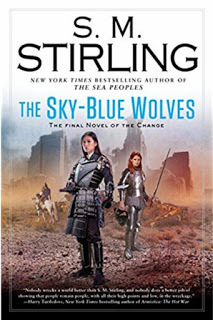 It all started with
Dies the Fire
, when "the lights went out," or when electricity stopped being useable to mankind. S.M. Stirling's alternative fiction series took off, Earth's population of billions plummeting, a few survivors creating enclaves with unique characteristics, and a new definition of normal arose. Readers of the Change series followed three generations through fifteen novels and one anthology until arriving at The Sky-Blue Wolves, "the final novel of the Change," as is clearly pointed out on the cover.
It all started with
Dies the Fire
, when "the lights went out," or when electricity stopped being useable to mankind. S.M. Stirling's alternative fiction series took off, Earth's population of billions plummeting, a few survivors creating enclaves with unique characteristics, and a new definition of normal arose. Readers of the Change series followed three generations through fifteen novels and one anthology until arriving at The Sky-Blue Wolves, "the final novel of the Change," as is clearly pointed out on the cover.I've followed the series and have read all its books, including the Island in the Sea of Time trilogy, which is loosely (or indirectly) connected, as the tail-side of a coin is indirectly connected to the head-side. Having read the final novel of the series, the biggest question is whether or not the novel provides closure. A secondary question is whether or not the novel stands on its own.
In order to answer the closure question, the structure of the Change series has to be considered. The first three novels of the series follow the first generation of survivors after the change. Action is centered on the different solutions different communities utilized and how those solutions shaped the personality of those communities. The initial trilogy chronicles the building of a new civilization in the Pacific Northwest and on the interactions (and wars) that occur. New centers of humanity arise and come to conflict, high among them the Mackenzie Clan and the Portland Protective Association, a Wiccan, Earth-magic community in conflict with a medieval, steel-gauntlet society.
The next seven novels center on the second generation, a battle between good and evil, and how the Change was not a one-shot event, that the initial Change "opened a door" that continues to widen into an age of myth, replacing the age of history. Forces are active that have been quiescent; gods once again walk the earth. The conflict extends, including western Canada and Iowa, all points between, yet also including action in the form of a quest that takes the characters through "dead zones" clear to the eastern seaboard and Nantucket Island.
The last five novels of the series follow the third generation. A new conflict has arisen and the new generation must meet it as have their parents and grandparents. Does The Sky-Blue Wolves provide closure to this sweep of Change and the evolution of new societies, where "modern" comes to signify medieval, or at least low-tech?
The short answer is that yes, the novel does provide an ending to the series. A great deal of the series revolved around how civilizations form around the personality of a charismatic leader or around a compelling idea. Stirling in all the novels returns again and again to this idea: that tradition provides continuity, and that the stability of continuity provides a platform for growth. A great deal of this final novel weaves the sweep of time and the significance of the foundations of these new societies into the action of the novel. Because of the novel's structure, at its end, the significant understanding is that the events of the novel fit into a larger pattern that will continue. There's a certain wisdom to that: knowledge of how life will continue is tempered by the sweep of experience of the earlier novels.
With all this "sweep" of fifteen novels, does The Sky-Blue Wolves firmly stand on its own as a story within itself? The first novel of the series, Dies the Fire, ends well, with stability achieved and a sense of how these newly-formed societies will continue. Stirling adds an epilogue to the novel to set up its sequel, but the novel ends well on its last chapter, the characters want to get home and continue on with their new lives. In the final novel, right at the end one of the characters says, "It's an ending, I suppose. And a beginning . . ." The series ends, yet the saga continues in our imagination.
The Sky-Blue Wolves has the challenge of ending the events of fifteen novels yet still having its own ending. It accomplishes that, yet the actual action of the novel has to endure the stifling effects of reiterating events from earlier novels (why a character or place is important) and providing or explaining perspectives to the action that justify the foundational concepts of the entire series. The action is necessarily dampened or truncated by the overriding awareness that this is the final novel. Also, this final novel is shorter than many of the other novels--one of the shorter ones. Whereas the earlier novels relied a great deal of swordplay and battles, this novel remained above the fray most of the time, and the ending battle didn't live up to its build-up. It's as if Stirling had to come up with a comic ending in order to enchant the reader away from the characters and action.
So, yes, the novel ends well, but perhaps it would be more apt to say the series ends well. Perhaps this is the great challenge of all novels that form a series, that latter novels have to use too much dead wood from the former. Perhaps that is why the feeling lingers in the background of the novels of the third generation of the Change that the author has grown tired or run out of new ideas, that the children are less vivid knock-offs of their parents. If I wanted to be harsh, I'd say this series began with a bang and ended with a whimper. However, as someone who has read the entire series, I do feel comfortable at its ending--good has triumphed over evil, life has triumphed over death, and the sky-blue wolves of the Mongols are once more howling down the mythic ends of the earth. To shift to another epic story, Beowulf is in his burial mound, and Wiglaf, a lesser man, carries on, sword in hand. We don't know Wiglaf's story and don't really want to. The real heroes remain the stirring stuff of legend, and the rest of us just get on with our work as best we can.

Published on November 21, 2018 04:18
November 6, 2018
Have Feet Will Travel

This is a beautiful fall. I am reveling in the brilliant colors of the leaves, and even the muted colors of the rain-filled sky and frost-bleached grasses. And the smells of this season, so rich with memories of the vibrant summer that are transmuted to earthy leaf mulch and wind-driven rain! My greatest joy is not just that the season has arrived; rather, it is that for some reason I am more aware this year of autumn's beauty, more linked to the natural rhythms of the season.
 Perhaps it is because I have bought a tiny trailer and am outside more this season, hiking and cooking, sitting by the campfire. My wife and I made the choice to change our environment, to buy the trailer so that we could have a "mobile office" where we could work yet be more outside. Now it is fall, and I am outside more, having packed my outdoor clothes--and glad to have done so! Even the cold knife of the wind is--what is the word?--bracing! The world is alive, and to move out into the natural world is to be reminded of those cosmic rhythms of life. It is easy to forget or ignore these natural rhythms when in a highly controlled environment.
Perhaps it is because I have bought a tiny trailer and am outside more this season, hiking and cooking, sitting by the campfire. My wife and I made the choice to change our environment, to buy the trailer so that we could have a "mobile office" where we could work yet be more outside. Now it is fall, and I am outside more, having packed my outdoor clothes--and glad to have done so! Even the cold knife of the wind is--what is the word?--bracing! The world is alive, and to move out into the natural world is to be reminded of those cosmic rhythms of life. It is easy to forget or ignore these natural rhythms when in a highly controlled environment.While my wife works her business, I write, and lots of my writing has been about our travel--the earth and sky and waters. I have to report that I think I'm getting better at it, but travel writing isn't as easy as it appears to be at first glance. As a fiction writer, I can say that traveloging is first and last driven by setting, by description of the natural world and the human world one experiences.
I recently posted a travel blog entitled "Fall Leaves and Camping, Please," where my wife and I spent five nights camping. "It's late October, just past the harvest moon, fifty-five degrees, and the trees are in full reds and yellows, the sky blues and grays, and the fire is a quiet companion as I sit and write at my camp at Jefferson County Park, a campground just four miles from my house."
In about a week I will be posting another piece at Green Goddess Glamping, entitled "Two Fall Nights on the Des Moines River," where I write about sharing my camp with rain showers and chainsaw instructors. The campground was carpeted with fall leaves. The river flowed just beyond the door to my tiny trailer. I took long walks along a nature trail and gravel roads. "I walked a mile down Hawk Drive along the Des Moines River, beautiful country with trees with brilliant foliage and stark white trunks mixed with evergreens, framed top and bottom by the cloudy sky and flowing river." I met fifteen young adults, all brandishing chainsaws.
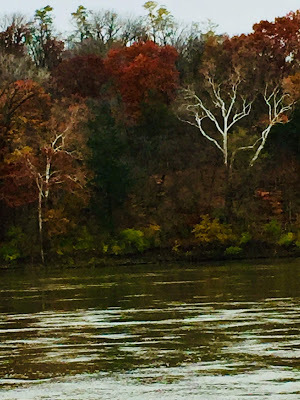
It was a journey worth taking, both for the outer and inner joys of the experience. Just as a cold fall rain is cleansing, so too can the experience of being in a cold fall rain be cleansing. And can there be anything more evocative than young adults happily felling invasive trees so that native species can re-establish themselves. Ah, the smell of sawdust in the early morning air!
I'm leaving tomorrow for Indian Lake for some cold weather camping. I want to learn how to be comfortable when the temperatures are in the 30's to the teens range. I believe it will involve warm clothing and a warm camper. I want to get outside, to enjoy the straightforward intelligence of nature, to live simply, and as I write this, I think I need to find my copy of Thoreau's Walden for reading. Simplify, simplify, simplify!
And I'll keep writing, because while beauty is in the eye of the beholder, that is only a partial truth. Beauty is everywhere, but only inside the beholder if our eyes behold it. I'm going to experience the bracing cold of the fall wind. There's a chance of snow flurries. That should wake me up and keep me moving.
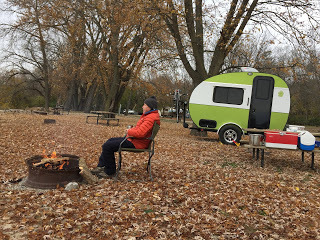
(Note: a great way to not miss my updates on writing or my traveloging is to sign up for email notifications for either (or both) blogs. Check the blog sidebars for the sign-up gadget.)

Published on November 06, 2018 04:07
October 21, 2018
Relax, Breathe, Write, Enjoy
 I know I'm going to have to revise. I always do, and I always enjoy revising.
I know I'm going to have to revise. I always do, and I always enjoy revising.Right now, I'm writing the first draft of a short story titled "Blade" at this time. Since it's a first draft, I'm just moving along at a steady pace . . . trying to relax, breathe, write, and enjoy. My strategy is working pretty well, and I'm progressing at a steady if not spectacular pace: 5,187 words so far.
I'm writing for other projects, too--this blog and another, a little of this and that.
I'm also focusing on my overall state of being, my level of rest and exercise, my diet and relationships. Writing has not been my engine for personal growth for a long time. It has more been a means to express my state of being, what I see and hear. I think that's healthy, avoiding the starving, suffering poet experience. I believe Philip Lamantia, a San Francisco Beat poet, described that pursuit akin to beating on the portals of perception until the hands are bloody. I've done a bit of that but prefer less blood and more joy.
Maybe I'll miss writing my great masterpiece because of that--but, really, I think I'm the masterpiece that's being written. It goes round and round, like the snake eating its tail.

Published on October 21, 2018 07:00
October 14, 2018
Not What's the Point But the Wholeness
 I've recently watched a couple of Netflix movies--started them and then fast forwarded through sections, ending the film, and then going back and closely watching key scenes. It was either fast and dirty or just turn the darn thing off. Then I clicked onto IMDB (International Movie Data Base) and read more about the movies and checked out some reviews.
I've recently watched a couple of Netflix movies--started them and then fast forwarded through sections, ending the film, and then going back and closely watching key scenes. It was either fast and dirty or just turn the darn thing off. Then I clicked onto IMDB (International Movie Data Base) and read more about the movies and checked out some reviews.Evidently, according to many reviews, I'm a shallow viewer who is so conditioned to the standard plot sequence normally presented that I cannot appreciate a truly artistic flick. And, according to the reviews, I am not the only creativity-challenged viewer.
The films viewed were Hold the Dark, a movie or survival and alienation set in the far, frozen North; and Under the Skin, a sci fi flick about an alien femme fatale with a gentler modus operandi than the Predator franchise.
I was tempted to ask what's the point of the movies, but I understand the concept that art doesn't need to mean, just be. Art's existence enlivens the mind and pulls one from boundaries to the unbounded. It expands.
 In the two films mentioned, a lot happens--death and destruction, despair and tragedy. However, in the end, I was not left with any sense of wholeness. I did appreciate the craft, but the vision was, as one reviewer wrote, left on the cutting room floor.
In the two films mentioned, a lot happens--death and destruction, despair and tragedy. However, in the end, I was not left with any sense of wholeness. I did appreciate the craft, but the vision was, as one reviewer wrote, left on the cutting room floor.I'm not here to bash Netflix, but as the company pours millions into new material, I certainly hope it doesn't end up being a lot of "B" grade material bought on the cheap because it got no traction anywhere else.
And as I write my current short story, I am reminded that although art doesn't have to justify its existence, that's only true when it is existence, when it is the drop of water that reflects the ocean. Without the reflection, the boundaries are too restrictive. I don't want my writing to reflect grey water in a grey world; neither do I want to watch movies where the only color is the grey sheen of lead bullets or the grey grime of roadside snow. Where's the sunshine? It's out there (and in there), and, Lord, let me not be distracted by all the shades and shadows between black and white.

Published on October 14, 2018 04:28
October 7, 2018
Words Per Day Make the Day
 It has been a week of writing on my short story "Blade," and I am reporting that moving back to my old standard of minimum words per day has been successful.
It has been a week of writing on my short story "Blade," and I am reporting that moving back to my old standard of minimum words per day has been successful.I began with a story fragment of 154 words and have written for a week, holding myself to at least two hundred words per day. Now the story is at 2,200 words. The good news, though, is that as I've been writing, the words written each day have grown, the last two or three days much more effortless and sustained.
I even missed one day of writing when I had an early doctor's check-up and other commitments, but I was already a little ahead of schedule, and the next day wrote more and caught up to my scheduled words.
The most engaging experiences have been those moments where I begin following a thread of plot possibility that I hadn't thought of until I began writing. Then I'm off into new territory, and it's quite fascinating witnessing myself write down the progressions and open in my mind. My experience is that this becomes more possible when the daily flow of words is established by routine.
That's the process, though, the first draft opening all the doors and windows. Or as e.e. cummings described the "spring" season experience: mud-luscious. Can't you just feel the mud squeezing up between your toes as you make your way down the path to the river?

Published on October 07, 2018 03:32
Words Per Day Makes the Day
 It has been a week of writing on my short story "Blade," and I am reporting that moving back to my old standard of minimum words per day has been successful.
It has been a week of writing on my short story "Blade," and I am reporting that moving back to my old standard of minimum words per day has been successful.I began with a story fragment of 154 words and have written for a week, holding myself to at least two hundred words per day. Now the story is at 2,200 words. The good news, though, is that as I've been writing, the words written each day have grown, the last two or three days much more effortless and sustained.
I even missed one day of writing when I had an early doctor's check-up and other commitments, but I was already a little ahead of schedule, and the next day wrote more and caught up to my scheduled words.
The most engaging experiences have been those moments where I begin following a thread of plot possibility that I hadn't thought of until I began writing. Then I'm off into new territory, and it's quite fascinating witnessing myself write down the progressions and open in my mind. My experience is that this becomes more possible when the daily flow of words is established by routine.
That's the process, though, the first draft opening all the doors and windows. Or as e.e. cummings described the "spring" season experience: mud-luscious. Can't you just feel the mud squeezing up between your toes as you make your way down the path to the river?

Published on October 07, 2018 03:32
September 30, 2018
Words Per Day--Inspiration by the Paragraph
 When I was writing The Stone Dragon, my routine was to write two hundred words per day, Monday through Friday, and then to write a thousand words over the weekend . . . minimum. Often I wrote more, but the minimum word count maintained my writing discipline. This was a reasonable routine for someone working full time and writing in spare time.
When I was writing The Stone Dragon, my routine was to write two hundred words per day, Monday through Friday, and then to write a thousand words over the weekend . . . minimum. Often I wrote more, but the minimum word count maintained my writing discipline. This was a reasonable routine for someone working full time and writing in spare time.My experience is that once I begin writing every day, I begin to think about the story throughout the day, to have realizations about the action and characters, to imagine new possibilities. On some quiet level, I begin to live the story; by that I mean its creation becomes a part of my everyday experience, which is enjoyable and also enchanting.
Now I've chosen to write a short story, tentatively titled "Blade." I've decided on the technical point of view, good old third person, and I feel pretty comfortable about the tone--telling the story as a legend in the making. So I'll write and write, and at some point it will feel like work because writing does take energy, but once the story is unfolding, a certain curiosity also pervails.
Now I need to get the dern thang written, and I'm falling back on my tried-and-true method of assigning myself a minimum daily writing amount--two hundred words. This, of course, is a very low "assignment," but I feel that will establish my daily routine for this duration of this story, and that the momentum of the story will carry the writing for a higher productivity. That's the plan!
Let's see in a week how far I've gotten.

Published on September 30, 2018 10:13
September 24, 2018
Putting Another Short Story on the Map

Spilling from the ancient Colina Calderon is the Lavan Labyrinth, lava spewed like outspread fingers creating grey wastes of razor-sharp rock interspersed with tiny, hidden valleys of grasses and secret round meadows of lying like islands of green amid volcanic desolation.
. . . Or at least the map I drew when I wrote my fantasy novel The Stone Dragon indicates. I've written five short stories set in the geography of that map since The Stone Dragon was published, and now I've started another, set in the Labyrinth and based on 154 words written by me eight years ago. I've been thinking about these 154 words for a few days, and now I have a direction to play around with. I always begin slowly, finding the voice of the tale by rewriting and experimenting with the beginning.
Once I get a good feel for the beginning, then I can sprint! I have to turn off my editor on the first drafts, though, to allow myself a chance to try something new, anything--to give myself the chance to miserably fail, with no failure since the only rule is to let creativity flow.
Here is the original sentence and two recent experiments:
Again the faint click of claw on riverstone, and he silently stood to face the sound.Again the faint click of claw on river stone. He turned to face the sound, his turning as silent as a dragonfly’s flight.It happened this way. Blade, he heard something, maybe a scree-scrape of claw on riverstone, but he’s not sure because it was gone too sudden, like an owl took it.As I read these, I'm telling myself, "Don't judge; don't judge!" You can see I'm playing around with tense, point of view, and characterization. Am I going to tell a tale passed down from parent to child? Is that too busy? I have no presumptions, just a willingness to play with the idea for a bit.
Oh, and it will include a mountain lion.
Wish me luck! I've already got the joy. I'm writing this right now from Lake Wapello State Park in SE Iowa. Pretty scenery, but (so far) no volcanoes or mountain lions!)
(Note: The last three posts I've boosted with a free $30 trial from Facebook. I'm not interested at this point in paying to boost more posts, since I'm focusing on writing now and not marketing. However, if you wish, feel free to share on FB, Google+, or whatever platform you are familiar with. Thanks!)


Published on September 24, 2018 14:08
September 16, 2018
Integrating My Writing into My Physical Environment
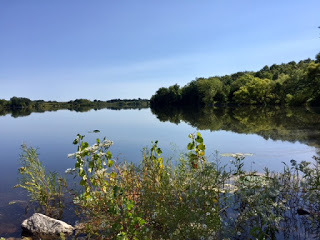 Lake Sugema lies to the north of our campsite, blue water and blue sky and the sun rising to light the lake. Last night the stars were brilliant in the sky. Thank you, a week of rain to clear the air and my rural setting to eliminate the light pollution of the city. Even with my ignorance of constellations, I could identify the Big and Little dippers and Orion's Belt. The Milky Way was a flung haze of stars in a swath across the heavens.
Lake Sugema lies to the north of our campsite, blue water and blue sky and the sun rising to light the lake. Last night the stars were brilliant in the sky. Thank you, a week of rain to clear the air and my rural setting to eliminate the light pollution of the city. Even with my ignorance of constellations, I could identify the Big and Little dippers and Orion's Belt. The Milky Way was a flung haze of stars in a swath across the heavens.My wife and I are here for five days, camping in our tiny trailer, she working from her mobile office and I writing in a variety of formats--daybook, text app, and online. I took a small hike this morning and a small nap this afternoon. I identified two varieties of oak, bur and southern red, this morning, sketched a bit with pen and colored pencils.
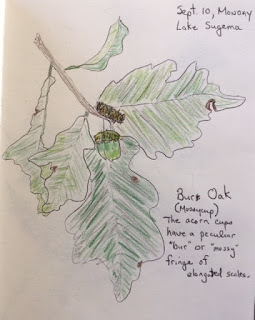 I've always enjoyed learning more about the world around me. I'm tired of knowing no more than "that's a tree," or maybe "that's a deciduous tree." Robert Hass's poetry book Field Guide is one of my favorites, a creative interaction with the natural world. I also love Donald Hall's Kicking the Leaves, especially the series of poems where he writes a poem for each season from the perspective of a bluff overlooking a river.
I've always enjoyed learning more about the world around me. I'm tired of knowing no more than "that's a tree," or maybe "that's a deciduous tree." Robert Hass's poetry book Field Guide is one of my favorites, a creative interaction with the natural world. I also love Donald Hall's Kicking the Leaves, especially the series of poems where he writes a poem for each season from the perspective of a bluff overlooking a river.Today I saw a magnificent tree with wide branching limbs, some as huge as the trunks of lesser trees. I knew from the leaves that it was an oak. Pulling out my Peterson First Guide to Trees of North America, I discovered there are over twenty variety of oak in North America. I knew the tree wasn't one of the evergreen oak varieties, and by comparing the leaves and acorns with the book's illustrations, I determined the oak tree was a bur (mossycup) oak because of the shape of its leaves and the fringe of elongated scales (the burs) on the acorn cups. Having identified the tree, I drew a sketch of the leaves and acorn in my daybook, including coloring with my dozen Crayola pencils. Great fun! Later I identified a southern red oak, its distinguishing features the thin shape of the leaf and the shallow shape of the acorn cup. A page in my daybook was dedicated to a leaf rub from the tree, followed by a written account in the daybook of my adventure. Not exactly Lewis and Clark, but fun research culminating in a better understanding of the trees around me and a unifying of my immediate personal life with my writing life.
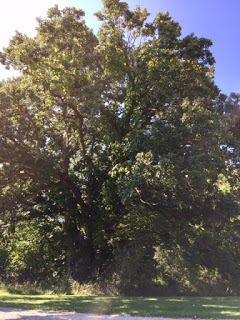 Now as I walk the trail and view the trees, I am aware of the many varieties of trees, the different leaf shapes and textures of the bark on the trunks. Such intellectual analysis isn't the only way to interact with the natural world, of course, but stimulating my intellect doesn't diminish my emotional appreciation or spiritual connection.
Now as I walk the trail and view the trees, I am aware of the many varieties of trees, the different leaf shapes and textures of the bark on the trunks. Such intellectual analysis isn't the only way to interact with the natural world, of course, but stimulating my intellect doesn't diminish my emotional appreciation or spiritual connection.I want to see the forest and the trees. Learning the names of the trees is a gesture of respect, an act of kinship. If you fear I might now describe how I hugged the trees, fear not. I am cautious. My wife and I also identified poison ivy turning read as we move toward fall. I have to be careful. How can I type if my hands are blistered from shaking hands with our colorful cousin?

Published on September 16, 2018 07:00
September 9, 2018
Keeping the Writing Process Concrete
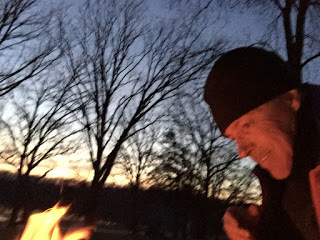
Starting out again after a hiatus from writing (which usually means less writing), I'm enjoying being able to see and touch my current day-to-day achievements. In that light, I'm continuing to write in my daybook and currently have more photos on order to paste onto pages and write about.
 I want to move toward writing fiction again, so I've been thinking about how I can concretize the experience to provide me with immediate feedback. I've decided first, to use an extra flashdrive to place all the short stories I've already written in one digital place. Not only is this an incentive (hold my stories in my hand!), but it is also practical. I find that over time my writing tends to get scattered--saved in different places . . . and misplaced. A second action step I'm taking is physically printing the stories and placing them in a box. As the box fills up, I can see my progress. I was inspired to do this by the story of John Steinbeck's writing of East of Eden. When he presented the manuscript to his editor, it was in a mahogany box. I don't know if I can find a mahogany box, but I'll find something.
I want to move toward writing fiction again, so I've been thinking about how I can concretize the experience to provide me with immediate feedback. I've decided first, to use an extra flashdrive to place all the short stories I've already written in one digital place. Not only is this an incentive (hold my stories in my hand!), but it is also practical. I find that over time my writing tends to get scattered--saved in different places . . . and misplaced. A second action step I'm taking is physically printing the stories and placing them in a box. As the box fills up, I can see my progress. I was inspired to do this by the story of John Steinbeck's writing of East of Eden. When he presented the manuscript to his editor, it was in a mahogany box. I don't know if I can find a mahogany box, but I'll find something.Right now, it's almost six in the morning, not yet dawn, and I can hear the rain falling outside. I've taken some time to write this little piece about writing, this little thought-moment about my writing life. I've done this now once a week for over a month, which I've published on this blog. Feels good.

Published on September 09, 2018 07:00



